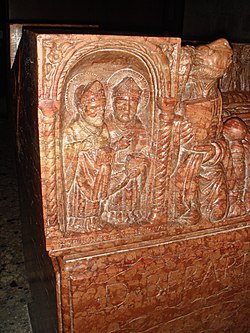| Saint Philastrius | |
|---|---|
 The holy bishops Apollonius and Philaster. Detail of the sarcophagus of Bishop Berardo Maggi The holy bishops Apollonius and Philaster. Detail of the sarcophagus of Bishop Berardo Maggi | |
| Died | ~397 AD |
| Venerated in | Catholic Church |
| Feast | July 18 |
Philastrius (also Philaster or Filaster) Bishop of Brescia, was one of the bishops present at a synod held in Aquileia in 381.
Life
Philastrius was born around 330 and ordained at the age of 30. According to Butler, "We know nothing of this saint’s country, only that he quitted it and the house and inheritance of his ancestors, like Abraham, the more perfectly to disengage himself from the ties of the world."
He traveled over nearly the whole Roman world (circumambiens Universum pene ambitum Romani Orbis), preaching against pagans, and heretics, especially the Arians. Like Paul of Tarsus he was scourged for his zeal against the Arians. In Milan he was a great pillar of the Catholic party in the time of Ambrose's Arian predecessor, Auxentius. Augustine of Hippo met him at Milan about 383, or perhaps a little later. At Rome he held both private and public disputations with heretics, and converted many.
His wanderings ceased when he was made Bishop of Brescia. He died some time before 387. Philastrius was buried in the ancient cathedral of St Andrew at Brescia. He is venerated as a Saint by the Catholic Church on 18 July each year, as noted in the latest official edition of the Roman Martyrology.
Historical evidence
Among the writings of Gaudentius of Brescia was a sermon purporting to be preached on the fourteenth anniversary of Philastrius's death. Historians such as Louis Ellies du Pin have questioned the genuineness of this sermon. Friedrich Marx thought the sermon a forgery of the eighth or ninth century. The chief objection to its genuineness, rather a weak one, seems to be that it is not found in the manuscripts containing the undoubted sermons of Gaudentius. Marx was answered by Knappe, "Ist die 21 Rede des hl. Gaudentius (Oratio B. Gaudentii de Vita et Obitu B. Filastrii episcopi prædecessoris sui) echt? Zugleich ein Betrag zur Latinität des Gaudentius" (Osnabrück), who endeavoured to prove the genuineness of the sermon in question by linguistic arguments. His Bollandist reviewer thought he has made a strong case (Anal. Boll., XXVIII, 224).
Works
Philastrius composed a catalogue of heresies (Diversarum Hereseon Liber) about 384. Richard Adelbert Lipsius discovered that in Philastrius's "Catalogue" of heresies, for the Christian heresies up to Noetus, the compiler drew from the same source as Epiphanius of Salamis, i. e. the lost Syntagma of Hippolytus. By the aid, therefore, of these two and the Pseudo-Tertullian Adversus Omnes Haereses it has been possible in great measure to reconstruct the lost treatise of Hippolytus.
Philastrius' comments and spellings do not always accord with those of Epiphanius or Pseudo-Tertullian, for example his description of Nazaraei does not match well with either the Nasaraioi or Nazoraioi which Epiphanius attempts to distinguish.
References
- Duffy, Patrick. "St Philastrius (AD. 397)", Catholic Ireland, 18 July, 2012
- Butler, Alban. "St. Philastrius, Bishop of Brescia, Confessor". The Lives of the Saints. Volume VII: July. 1866
 This article incorporates text from this source, which is in the public domain.
This article incorporates text from this source, which is in the public domain.
- "Philaster, bp. of Brixia", A Dictionary of Early Christian Biography (Henry Wace, ed.) John Murray, London, 1911
- ^ Bacchus, Francis Joseph. "St. Philastrius." The Catholic Encyclopedia Vol. 11. New York: Robert Appleton Company, 1911
 This article incorporates text from this source, which is in the public domain.
This article incorporates text from this source, which is in the public domain.
- Martyrologium Romanum, ex decreto sacrosancti oecumenici Concilii Vaticani II instauratum auctoritate Ioannis Pauli Pp. II promulgatum, editio altera, Typis Vaticanis, A.D. MMIV (2004), p. 398 ISBN 88-209-7210-7
- Edwin K. Broadhead Jewish Ways of Following Jesus: Redrawing the Religious Map of 2010 p178 "52 Filaster apparently has another group in mind when he refers to Nazaraei. His description of them elsewhere does not match well with the Nazarenes of Epiphanius. Even if Filaster means the Nazarenes, he may be dependent on Epiphanius"
[REDACTED] This article incorporates text from a publication now in the public domain: Herbermann, Charles, ed. (1913). "St. Philastrius". Catholic Encyclopedia. New York: Robert Appleton Company.
Editions
- The first edition of the "Catalogue" was published at Basle (1528)
- F. Marx, Philastrius (Vienna, 1898) in the Corp. Script. Eccl. Lat.
- Gabriele Banterle, translator, (1991, Rome) San Filastro di Brescia, Delle varie eresie / San Gaudenzio di Brescia, Trattati
External links
- Opera Omnia by Migne Patrologia Latina
- Carla Setién (2017, Santiago de Compostela) “Herejes en el Antiguo Testamento según Filastrio de Brescia”, in (Re)escribindo a Historia. Achegas dos novos investigadores en Arqueoloxía e Ciencias da Antigüidade, Andavira, pp. 155–170.
- Carla Setién (2018) “La transformación de la cultura clásica en el s. IV: el caso de Filastrio de Brescia”, SPhV 20, pp. 195–216.